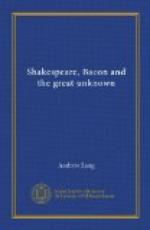I do not know who drew the design, but a travesty of Jacobean work it is in every detail of the monument. A travesty is what Dugdale gives as a representation of the Carew monument. Mr. Greenwood, elsewhere, repeating his criticism of the impossible figures of children, says: “This is certainly mere matter of detail, and, in the absence of other evidence, would give us no warrant for doubting the substantial accuracy of Dugdale’s presentment of the ‘Shakespeare’ bust.” {180a}
Why are we to believe that Dugdale’s artist was merely fantastic in his design of the children (and also remote from Jacobean taste in every detail), and yet to credit him with “substantial accuracy” in his half-length of a gloomy creature clutching a cushion to his stomach? With his inaccuracies as to the Carew monument, why are we to accept him as accurate in his representation of the bust? Moreover, other evidence is not wanting. It is positively certain that the monument existing in 1748, was then known as “the original monument,” and that no other monument was put in its place, at that date or later.
Now Mrs. Stopes {180b} argues that in 1748 the monument was “entirely reconstructed,” and so must have become no longer what Dugdale’s man drew, but what we see to-day. It is positively certain that her opinion is erroneous.
If ever what we see to-day was substituted for anything like what Dugdale’s man drew, the date of the substitution is unknown.
Mrs. Stopes herself discovered the documents which disprove her theory. They were known to Halliwell-Phillipps, who quotes an unnamed “contemporary account.” {181a} This account Mrs. Stopes, with her tireless industry, found in the Wheler manuscripts, among papers of the Rev. Joseph Greene, in 1746 Head Master of the Grammar School. In one paper of September 1740 “the original monument” is said to be “much impaired and decayed.” There was a scheme for making “a new monument” in Westminster Abbey. That, I venture to think, would have been in Hanoverian, not in Jacobean taste and style. But there was no money for a new monument. Mrs. Stopes also found a paper of November 20, 1748, showing that in September 1746, Mr. Ward (grandfather of Mrs. Siddons) was at Stratford with “a cry of players.” He devoted the proceeds of a performance of Othello to the reparation of the then existing monument. The amount was twelve pounds ten shillings. The affair dragged on, one of the Church-wardens, a blacksmith, held the 12 pounds, 10s., and was troublesome. The document of November 20, 1748, was drawn up to be signed, but was not signed, by the persons who appear to be chiefly concerned in the matter. It directed that Mr. Hall, a local limner or painter, is to “take care, according to his ability, that the monument shall become as like as possible to what it was when first erected.” This appears to have been the idea of Mr. Greene. Another form of words was




